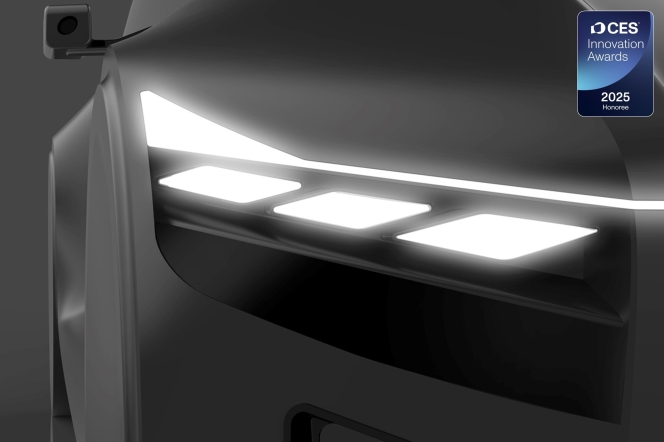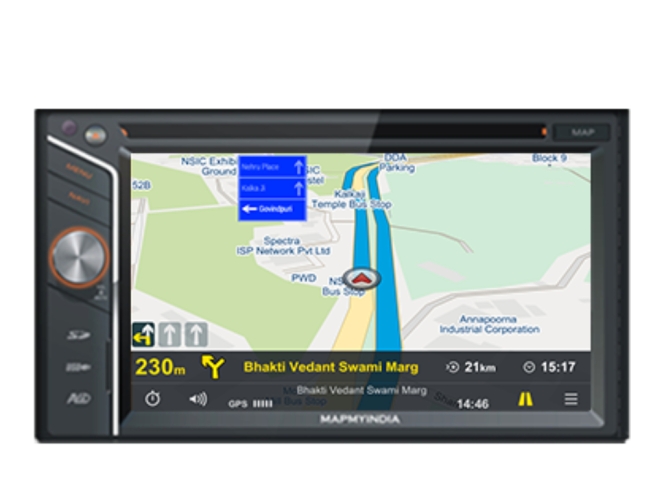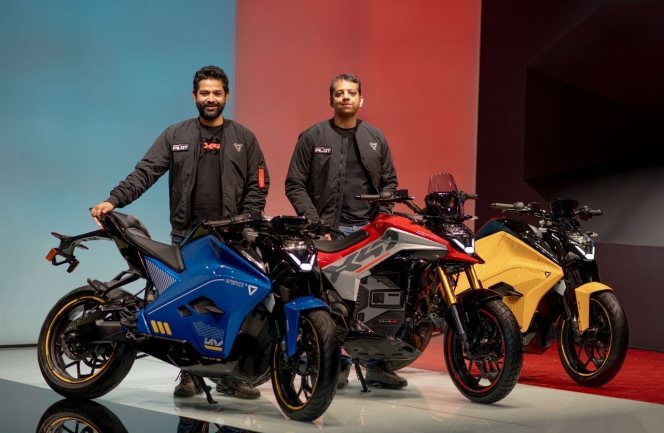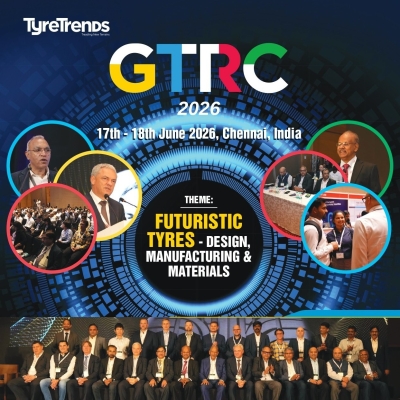- LG Innotek
- Nexlide A+
- LG Group
- vehicle lighting
- surface lighting
- Consumer Electronics Show
- CES
- CES 2025
- Consumer Technology Association
- CTA
- Moon Hyuksoo
LG Innotek’s Nexlide A+ Vehicle Lighting Module Bags CES 2025 Innovation Award
- By MT Bureau
- November 25, 2024

LG Innotek, a LG Group company focussing on automotive radar and lighting solutions among others, has been awarded the Consumer Electronics Show (CES) Innovation Award, for its vehicle lighting technology.
On 21 November 2024, LG Innotek announced that its 'Nexlide A+ automotive lighting module' received the CES 2025 Innovation Award from the Consumer Technology Association (CTA) in the United States.
The CTA recognises products and services of exhibitors that stand out for their technology, aesthetics, and innovation.
The 'Nexlide A+' is a product in LG Innotek's Nexlide series, a brand focussing on automotive lighting solutions. It is said to be the first lighting module in the industry to apply a surface light source to the front lighting module of a vehicle.
LG Innotek said that unlike typical point light sources, a surface light source emits light evenly across the entire surface. It has secured more than 700 patents related to the technology.
For a vehicle lighting module using a conventional point light source to achieve a similar effect to a surface light source, a separate component is required to spread the light from the point light source evenly, such as a light guide. In addition, the air gap, which is a layer of air required for light diffusion, needs to be thicker.
The front lighting module, due to being located at the front of the vehicle, is exposed to high temperatures and needs to be equipped with a heat dissipation structure to remove heat. This makes existing point light source products bulky, which limits design flexibility.
In comparison, the 'Nexlide A+' uses LG Innotek's unique surface light source technology to produce uniform brightness without such additional components, which also makes the module 40 percent slimmer than the existing product. This allows for efficient space utilisation and greater flexibility in vehicle design.
In addition, the company has further improved heat dissipation performance by applying high heat-resistant resin coating and film technology. The brightness has also been increased fivefold compared to conventional rear-facing lighting products, meeting the global legal standard of 500cd (candela, a unit representing the brightness of a light source) for daytime running lights (DRLs).
Till date, the company has completed more than 140 projects with domestic and foreign automotive brands and accumulated more than 150 orders. Over the past 10 years, it has recorded an average annual sales growth rate of 47 percent.
Looking ahead, LG Innotek plans to expand its lineup of rear-lighting modules to include front-lighting models. By 2025, the company also aims to develop ‘pixel lighting’ technology, which features small, three-dimensional lights arranged in a grid-like pattern. This advancement it expects to facilitate communication between vehicles(V2V) and pedestrians(V2P) enhancing safety and interaction.
Moon Hyuksoo, CEO, LG Innotek, said, "LG Innotek is solidifying its position in the global market as a total solution provider of future mobility components. With innovative products, we will grow the automotive lighting module business into a trillion-dollar industry by 2030, delivering unique value to our customers."
In January, LG Innotek will present a range of differentiated products at CES 2025, including the 'Nexlide A+' and other vehicle lighting modules as well as LiDAR (Light Detection Ranging) and sensing components for autonomous driving applications.
Greaves Cotton Appoints Santosh Singh As Chief Strategy And AI Officer
- By MT Bureau
- December 16, 2025

Greaves Cotton has appointed Santosh Singh as Chief Strategy and AI Officer. He will be based in Mumbai and will lead strategy, transformation, AI-led enterprise capability building and business excellence for the Greaves Cotton Group.
Singh comes with over two decades of experience in strategy, business excellence, innovation, and AI-led enterprise transformation. He joins Greaves Cotton from Tata Technologies (TTL), where he served as Global Head – Marketing and Business Excellence. During his tenure there, he co-led the enterprise GenAI roadmap and developed use cases focused on customer engagement and productivity.
His primary mandate is to drive the Greaves.NEXT strategy, the company’s roadmap for growth across the energy, mobility and industrial solutions sectors.
In his new role, Singh will focus on accelerating growth for Greaves Technologies (GTL), developing an enterprise-wide AI roadmap, and establishing partnerships with hyperscalers and AI labs.
Parag Satpute, Managing Director & Group CEO, Greaves Cotton, said, “We are pleased to welcome Santosh to the leadership team. His extensive expertise in strategy, digital transformation, and AI will play a significant role in shaping Greaves’ next phase of growth. His global experience will further strengthen our innovation roadmap and support our long-term business priorities.”
Singh will also work across business units to incubate and scale growth vectors and lead business excellence initiatives.
Luminar Sells Photonics Division To Quantum Computing Inc For $110 Million
- By MT Bureau
- December 16, 2025

Luminar Technologies, Inc., a global technology company advancing safety, security and autonomy across various sectors, has announced it has agreed to sell its wholly owned subsidiary, Luminar Semiconductor, Inc. (LSI), to Quantum Computing Inc. (QCi) for USD 110 million in an all-cash transaction.
QCi is an integrated photonics and quantum optics technology company focused on photonics-driven technologies and sensing applications. LSI's innovation platform and engineering depth align with QCi’s strategic priorities in optical systems, chip-scale innovation and photonic architectures. The acquisition is expected to position LSI to grow and capitalise on the demand for photonics solutions.
Paul Ricci, CEO, Luminar, said, "We are pleased to partner with QCi as they continue to accelerate their photonics roadmap. QCi’s focus on photonics-driven technologies provides an aligned platform for LSI to expand its customer base, accelerate growth opportunities, and invest in markets where long-term demand for high-reliability optical systems is increasing. We are incredibly proud of the LSI team for the progress they have made to reach this milestone, and we are excited for the opportunities ahead for LSI under QCi’s ownership.”
Yuping Huang, CEO, Quantum Computing Inc, said, "I’m excited about the opportunity to partner with the exceptional team and valued customers of LSI. There is clear strategic alignment and shared vision between our organizations, creating strong momentum from day one. Following the closing, we will move quickly to invest in and scale LSI’s existing business, while bringing our teams together to accelerate our quantum photonics roadmap. This is a powerful combination, and I’m energized by what we will achieve together.”
In a separate announcement, Luminar announced that it has initiated voluntary chapter 11 cases in the U.S. Bankruptcy Court for the Southern District of Texas. LSI is not a debtor in the chapter 11 cases and is operating in the ordinary course. Because LSI is a subsidiary of Luminar, the transaction will require the approval of the bankruptcy court via a Section 363 sale process, which the parties expect to receive by the end of January 2026, subject to closing conditions.
Neusoft And MapmyIndia Partner For Intelligent Mobility Solutions
- By MT Bureau
- December 06, 2025

Chinese technology company Neusoft Corporation and Mappls MapmyIndia have signed a Memorandum of Understanding (MoU) to leverage their strengths in software and data resources to collaborate deeply.
The companies will engage in joint technological development, ecosystem collaboration and resource integration to provide navigation products and intelligent mobility solutions tailored to localised needs in emerging markets such as Southeast Asia and India.
The partnership is a response to the fact that while global auto brands are expanding into Southeast Asia and India, they face challenges in these regions due to complex road conditions, unique traffic rules, extensive addressing systems and high localisation adaptation costs. These issues limit the ability of automakers to deliver a complete intelligent user experience.
Under the collaboration, Neusoft will adopt its OneCoreGo Global Intelligent Mobility Solution 6.0 Plus as the core technology carrier, deeply integrating MapmyIndia's map data, real-time traffic information and multi-dimensional value-added services. MapmyIndia is noted as the largest local mapping company in India, holding more than 90 percent market share in in-vehicle navigation.
The integration is intended to strengthen a full capability loop of ‘navigation + payment + interaction + connectivity + operations’.
Through API integration and technological convergence, the two parties will jointly develop navigation products and mobility solutions highly adapted to Southeast Asia, India and similar regional markets. These solutions will deliver precise route planning and real-time traffic guidance, address local user needs and continuously enhance product experience and scenario-based services. This will help automotive partners rapidly launch intelligent vehicle models with competitiveness in local markets.
The partnership enables Neusoft to combine the global end-to-end strengths of its solution with localised ecosystem resources, paving the ‘last mile’ for automakers entering the Southeast Asian and Indian markets and delivering comprehensive intelligent mobility experiences.
- Ultraviolette Automotive
- Zoho Corporation
- Lingotto
- F77
- X-47
- Shockwave
- Tesseract
- Narayan Subramaniam
- Niraj Rajmohan
Ultraviolette Secures $45 Million Growth Capital From Zoho And Lingotto
- By MT Bureau
- December 04, 2025

Bengaluru-based electric vehicle maker Ultraviolette Automotive has secured USD 45 million from Zoho Corporation and Lingotto, one of Europe's investment management companies as part of its ongoing Series E investment round.
The investment from Zoho Corporation was led by Sridhar Vembu, Mani Vembu and Kumar Vembu.
This growth capital will accelerate the domestic and international scale-up of current products F77 and X-47, as well as future product platforms Shockwave and Tesseract.
Ultraviolette has built a design and technology-led enterprise with the F77 and the recently launched X-47.
The company has expanded to 30 cities across India in a short span of 12 months and is expanding to 100 cities by mid-2026. The F77 motorcycles were recently launched in the United Kingdom, bringing Ultraviolette's presence to 12 countries across Europe.
Narayan Subramaniam, Co-Founder & CEO, Ultraviolette Automotive, said, “We are glad to announce our Series E investment from Zoho and Lingotto. Lingotto's legacy of backing iconic performance and mobility brands, combined with Zoho's long-term commitment to fostering cutting-edge Indian innovation, aligns perfectly with Ultraviolette's mission to build category-defining electric mobility solutions for India and global markets.”
Niraj Rajmohan, CTO & Co-Founder, Ultraviolette, said, "With the ongoing Series E investments, we are doubling down on growth and expanding our production to meet increasing demand. Our focus is on advancing breakthrough battery technology, elevating performance capabilities and expanding production to support upcoming product platforms. This investment will accelerate our journey towards scaling into India and global markets."






Comments (0)
ADD COMMENT